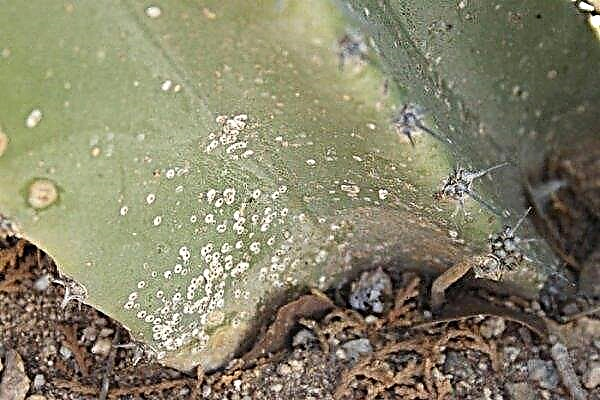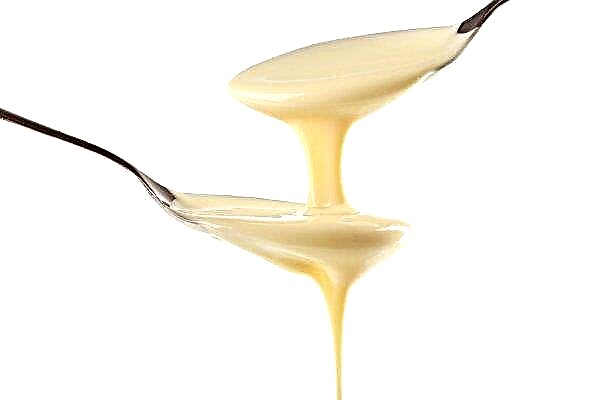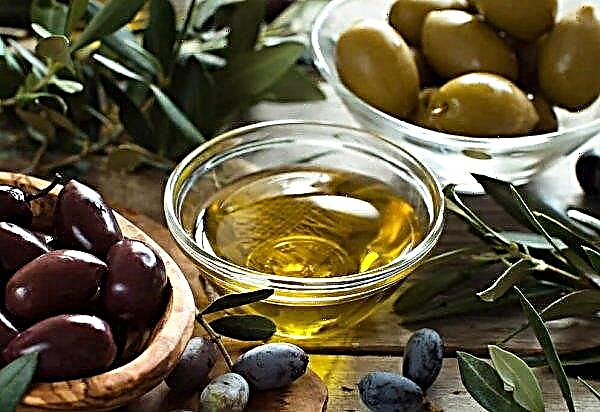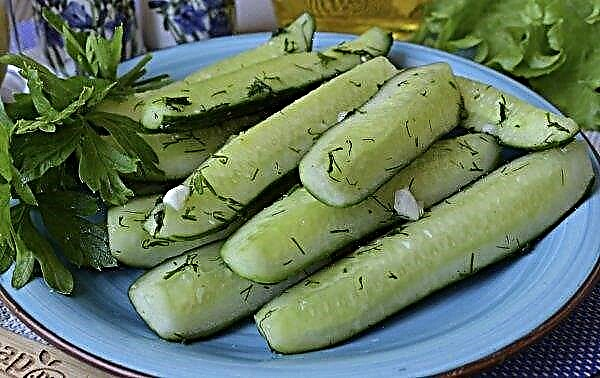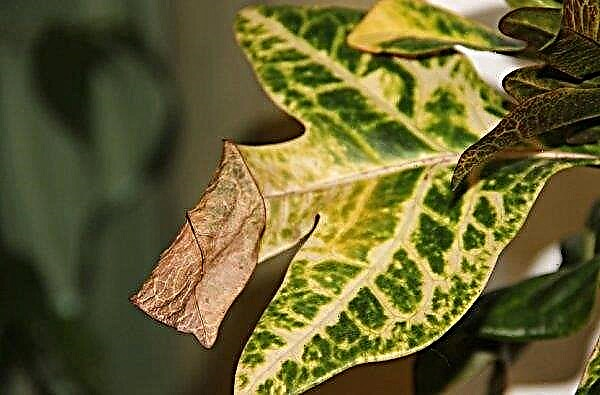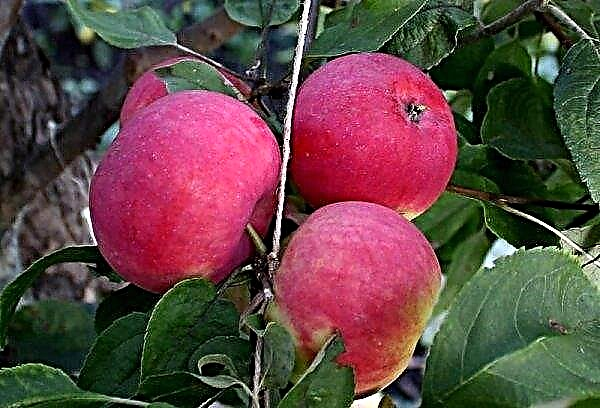Pickled tomatoes are an excellent alternative to pickles, and some housewives like them even more than traditional preservation. An additional advantage of harvesting tomatoes in this way is a wide selection of suitable spices that can give vegetables a rich and very unusual taste. In this article we will consider a number of interesting recipes, but first we’ll recall the rules for preparing vegetables and containers for the preservation process.
Preparation for conservation
Not all tomatoes are equally well suited for conservation, so even at the stage of choosing vegetables, you need to know which tomatoes are worth buying.

The main requirements include the following criteria:
- variety and degree of ripening (in one bank it is worth closing the fruits of only one variety, with approximately the same, average level of maturity);
- tomato size (small and medium fruits are considered the best option for marinating, it is advisable to leave large tomatoes for making juice or pasta);
- product quality (selected specimens should not have any defects, cracks or stains);
- skin thickness and elasticity (so that the fruits do not turn into a jar in the jar, you should choose only varieties with a hard shell or mid-ripening).
The second important point of the preparatory phase is the sterilization of cans, which is carried out using a microwave, oven or steam that appears over a pot of boiling water.
Consider each option:
- Microwave sterilization of containers - one of the simplest options for performing the procedure. All that is required is to pour a little water on the bottom of the cans and set them up while standing in the microwave. After that, the microwave oven is transferred to 800 watts and, having closed the door, press the start button. As the water evaporates, the cans will be steamed and sterilized. When there is absolutely no water left, they can be taken out and used for their intended purpose.
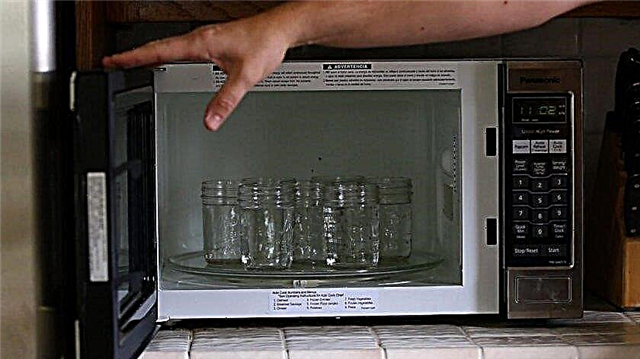
- Processing cans in the oven. This option involves placing the cans (neck down) in an initially cold oven, the temperature in which is gradually brought up to +150 ºC. At this maximum, the container should warm up for 15 minutes, after which it is removed and used for its intended purpose.
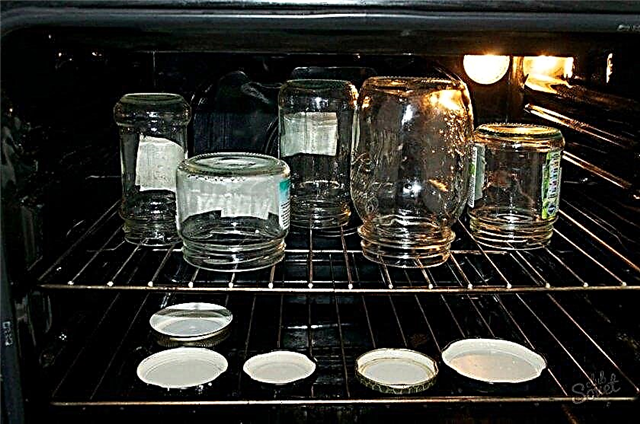
- Steam sterilization. In this case, put a pot of water on the stove, and install a grate on top of it. Inverted cans are set up on this grate, which will be disinfected with boiling water using steam. Sterilization of containers is considered complete as soon as droplets of water appear on the walls of the container and begin to flow down the walls.

- The process of processing containers in a double boiler is identical to the previous option: the cans are turned upside down and left inside the appliance for 15 minutes (mode - “cooking”).

To prepare for pickling tomatoes, any of the described methods of sterilization is suitable, because the main thing here is not the process, but the final result.
Jar pickling recipes for winter
As we have already said, there are a lot of recipes for creating pickled tomatoes, so each housewife will be able to choose the most interesting option for herself. Let's consider some of them.
Did you know? As early as the beginning of the 19th century, tomatoes were considered poisonous plants, and it never occurred to anyone to taste exotic fruits. This continued until in 1822, Colonel Robert Johnson publicly ate a bucket of tomatoes, thereby proving their safety for the human body.
Flavored pickled tomatoes
This recipe can easily be described as an "amateur", because not all consumers like the large combination of taste shades. The advantage of such a workpiece is the ability to use absolutely any spices that will help expand the list of main ingredients.
In the standard version it includes:
- tomato fruits - 1-3 kg, which depends on the volume of the jar (1.5 or 3 l);
- salt - 1-2 tbsp. l .;
- sugar - 2–4 tbsp. l with a slide;
- vinegar essence - 50–75 ml;
- horseradish leaves - 1-2 pcs. to the can;
- dill umbrellas - 1-2 pcs.;
- parsley - several branches;
- currant and cherry leaves - 5 leaves each;
- horseradish root - 1-2 pieces;
- garlic cloves - 2-3 pcs. to the can;
- black and allspice - 3-5 peas.
In addition, to improve the taste of the finished workpiece and give it a certain piquancy, it is useful to put clove buds, half a cinnamon stick, several mustard seeds, onions and hot peppers in the jars.
The process of creating a workpiece with different tastes takes place in the following order:
- To begin with, on the bottom of sterilized jars, you need to lay on a branch of dill umbrellas and parsley leaves, and also place a torn piece of horseradish inside.

- On top of the green base, lay out the tomato fruits themselves (better than the average size). Usually they are laid in a dense layer, but nevertheless, tomatoes do not need to be pressed strongly.
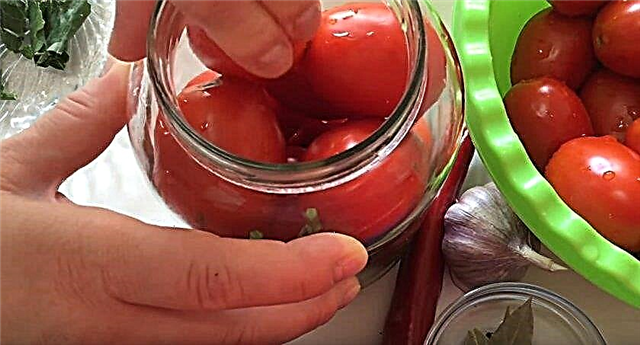
- The vegetables in the jar should be steamed, pouring boiling water over them twice: first for 10 minutes, and then for 5. When pouring boiling water, try to pour the liquid not on the walls, but on the fruits themselves so that the glass does not crack.
Important! To avoid a sharp pressure drop when the temperature changes and, as a result, cracks in the skin or complete cracking of the fetus, you can make small punctures in the area of the stalk. For this purpose, a wooden toothpick is ideal.
- After draining the liquid after the second steaming, add a few bay leaves to the tomatoes (can be placed near the walls or between the tomatoes themselves), 3-5 peas of black and allspice, chopped garlic cloves, salt, sugar and vinegar, which is simply poured on top of the vegetables. If you plan to add mustard, cloves, cinnamon or other spicy ingredients, then you also need to add them to the container at this stage.
- Boil water and pour the tomatoes so that the liquid completely covers them.
- Cork jars with screw caps, turn them upside down and make sure that they do not leak liquid.
- Ready-made preservation can be additionally wrapped in a blanket and left in the kitchen until it cools completely, so that later it can be taken out to a cooler room.
Video: Pickled tomatoes with different flavors
Sliced with onions (“You'll lick your fingers”)
Unlike previous recipes, this one is attractive in that any tomatoes are suitable for it, regardless of variety, size and shape. In addition, the so-called non-condition, which is not suitable for other types of conservation, can also be rolled into banks.
For one half-liter jar, you will need the following amount of ingredients:
- tomato fruits - 300 g;
- onion - 1 pc.;
- garlic - 1 clove;
- dill umbrellas - 1 pc.;
- currant and cherry leaves - 1-2 pcs.;
- bay leaf - 1 pc.;
- black pepper - 3-4 peas;
- allspice - 1-2 peas.
To create a marinade for one half-liter jar, you need to take 250 ml of water, ¼ part of a tablespoon of salt, the same spoon of sugar (only without a slide), 15 ml of table vinegar.Important! If you take the hot jars to the cold, then there is a high probability of cracking the glass or exploding lids, so you should leave the freshly pickled tomatoes in the room until they cool completely.
The process of preparing pickled tomato slices with onions is as follows:
- Wash the selected tomatoes, dry and cut into slices, after cutting the petiole area and all the damaged areas.
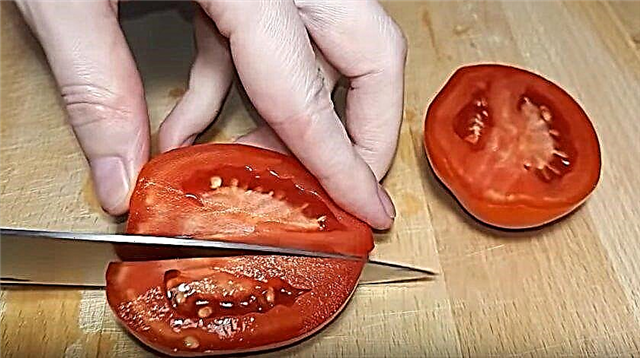
- Cut the onion into rings no more than 5 mm thick, and then disassemble it into separate parts.
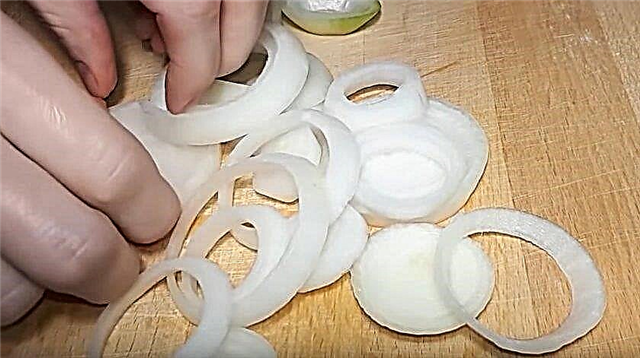
- Rinse the dill, currant and cherry leaves and leave them to dry a little.
- Sterilize the cans and the screw metal caps supplied with them.
- In each prepared jar, put onion rings, an umbrella of dill, 2 leaves of cherries and currants, a clove of garlic cut into 4 parts, bay leaf, black and allspice. If desired, you can supplement this mixture with mustard seeds, carrot slices or clove inflorescences.
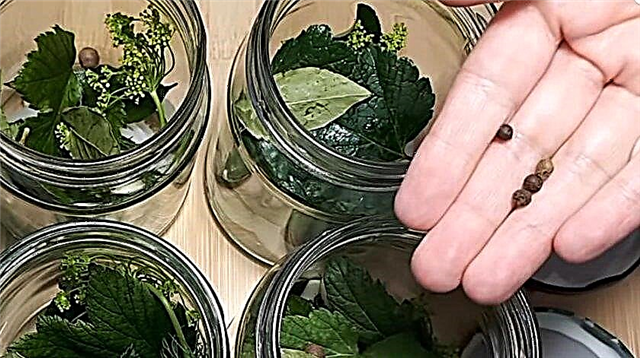
- Following the greens, put in a jar pieces of chopped tomatoes, placing them in layers separated by onion rings.

- Now take care of the marinade, for which in a separate pan you need to add salt and sugar to the water, and then put this mixture on the stove and boil.
- When the components completely dissolve in the liquid, remove the mixture from the heat and add a measured amount of vinegar.
- Pour the filled cans with the finished marinade and cover with lids without twisting them.
- Put the filled jars in a large pan (it must be covered with a cloth in advance) and pour them with warm water and put on gas. The sterilization time for half-liter jars is 7-8 minutes (from the moment the water boils in the pan).
- After the specified time, the cans can be removed and tightly corked with either screw or conventional seaming lids.
- Turn preservation over, wrap it well and leave to cool completely.
To the table, such a salad can be served with any side dish or in addition to a meat dish.
Video: Preservation of tomatoes with slices
Cherry tomatoes
With small cherry tomatoes, a little more fuss than with fruits of large varieties, but their size is largely the advantage of such tomatoes (at least, this harvest will already be divided into small portions).
Preparing a pickled product is not difficult, the main thing is to correctly calculate all the proportions:Did you know? The first variety of small cherry tomatoes was bred in Israel in 1973, and since then these tomatoes have been constantly improved: breeders did not get tired to cross them with other varieties of tomatoes. In part, this has led to the fact that new varieties of cherry tomatoes retain their freshness and useful properties longer than others.
- tomatoes - 2.5 kg;
- bell pepper - 2 pcs.;
- garlic - 2 heads;
- dill umbrellas - 2 pcs.;
- horseradish leaves - 1-2 pcs.;
- hot pepper - 1 pod;
- vinegar - 1 tbsp. to the can;
- salt - 1 tbsp. l .;
- sugar - 100 g.
In preparation of blanks according to this recipe, everything is extremely simple, because in many respects the actions performed correspond to other similar processes:
- First you need to wash the cherry tomatoes, rinse the greens under running water and peel the bell peppers. Hot peppers are cut into small circles.

- Prepared vegetables need to be put in a jar, overlying layers of dill, horseradish leaves and small parts of bell pepper. It is also worth immediately adding chopped garlic and several parts of hot pepper.
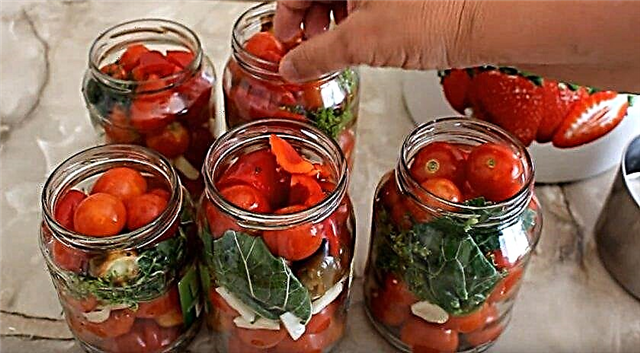
- After filling the cans, freshly boiled water is poured into each of them, covered with lids and left for 5-10 minutes so that the tomatoes are steamed well.
- After this time, the liquid needs to be poured into a separate saucepan, add sugar and salt, and then send all this to the fire to boil (sugar and salt should completely dissolve).
- While the marinade is being prepared, 1 tbsp must be added to each container with tomatoes. vinegar.
- Following vinegar, a boiling mixture of water, salt and sugar is poured into the jars, trying to immerse all the tomatoes in the liquid.
- Filled containers can only be closed with lids and left in the room until completely cooled, and it is not necessary to turn the seals upside down.
In general, pickled cherry tomatoes are not much different from a similar harvest from other tomato varieties, but the specific taste of this particular variety is still felt.
Video: Cherry Tomato Preservation
With cucumbers
This option is suitable for those housewives who appreciate vegetable salads in jars. Cucumbers perfectly complement the taste of tomatoes, and they, in turn, make them much more piquant due to the secreted acid.
To prepare a mix of pickled tomatoes and cucumbers, you will need:
- cucumbers - 1–1.5 kg;
- tomatoes - 1-1.5 kg;
- carrots - 1-2 pcs.;
- sweet pepper - 1-2 pcs.;
- cherry leaves - 6–8 pcs.;
- horseradish leaves - 4–5 pcs.;
- currant leaves - 6–8 pcs.;
- garlic - 2 heads;
- horseradish root - 1-2 pcs.;
- vinegar - 2 tbsp. l
From this amount of ingredients, you will get about 2 three-liter cans of the finished workpiece, and if you need less preservation, then you can reduce the number of individual components, just always do it proportionally.
Cooking method:
- Take a suitable pan, pour about 3 liters of water into it and put on fire. When the liquid boils, toss the bay leaf, black pepper and peas, and pour vinegar in a few minutes.
- While the marinade is cooking, peel the garlic and cut each slice into 2-3 parts, then peel and cut the bell pepper into large slices. Cut slices and peeled carrots.
- At the bottom of the sterilized jar, lay the leaves and horseradish root, cut in small pieces, add currant and cherry leaves, sliced garlic and dill seeds there.
- On the base of greens, lay the cucumbers, only so that they occupy half the jar and are placed vertically.
- On the other hand, pour the tomatoes, and on top lay on them slices of sweet pepper, circles of carrots and a few more small cucumbers, if there is room for them.
- Fill the filled jar with boiled marinade and cover with a lid for 10 minutes.
- Drain the marinade back into the pan and boil again for several minutes, adding a few more bay leaves, as well as a couple of peppercorns.
- After the second boiling, the liquid is poured into cans and is no longer drained, tightly closing the container with lids.
Thus, it turns out that both banks and vegetables are sterilized twice, and the marinade itself is better nourished by the smell and taste of all the ingredients. Finished seals can be left in the kitchen or immediately transferred to a heated pantry.
Video: Pickled tomatoes with cucumbers
With garlic "in the snow"
A very interesting recipe for pickling tomatoes, especially for those who are already tired of the monotony in this matter. With a minimum of spices, preservation is very tasty and even sweet, and this despite the presence of a large amount of garlic.
The main things you will need to create “tomatoes in the snow” are:
- tomato fruits - 2–2.5 kg;
- garlic - 5–6 large heads;
- salt - 1.5 tbsp. l .;
- sugar - 150 g;
- vinegar essence - 1.5 tbsp. l

The cooking process involves the following actions:
- Wash the tomatoes, peel and wash the garlic, steam the cans and lids to them.
- Poke each tomato several times with a toothpick in the area of the fruit stem, chop the garlic with a blender.
- Put the tomatoes in a prepared container without cutting them into halves (especially if all the fruits are of the same shape).
- Pour boiling water over the fruits, cover and let stand for 15 minutes.
- Drain the water into a measuring container (it will be easier to calculate the necessary proportions) or immediately into a pan.
- Put the container with the marinade on the stove, dissolve the sugar, salt, vinegar essence in it and let the mixture boil.
- Add chopped garlic to jars of tomatoes, at a rate of about 1.5 tbsp. on one two-liter jar. Spread it evenly over the surface and in between the joints of the tomatoes.
- Fill the tomatoes with boiled brine and roll the lid.
Important! If screw metal caps are used to clog cans, always squeeze them well, because, in comparison with correctly used seamers, they often pass liquid.
- Turn the jar over and shake its contents well so that the garlic mixes with the brine. Send the workpiece for storage.
Video: Tomatoes “in the snow”
With carrot tops
The green part of carrots is usually thrown away or, at best, given to farm animals, but with skillful preparation, it can be an excellent ingredient in pickled tomatoes.
The recipe for harvesting with carrot tops provides for the following ingredients (per 1 liter of marinade):
- tomato fruits - 1–1.5 kg;
- carrot tops - at least 5-6 branches per can;
- salt - 1 tbsp. l .;
- sugar - 4 tbsp. l .;
- citric acid - 1 tsp;
- tops of carrots - 1 bunch;
- garlic - 4 prongs;
- clove bud - 2 pcs.;
- black pepper (peas) - 4–5 pcs.;
- bay leaf - 1 pc.;
- dill umbrellas - 1-2 pcs.;
- hot pepper (if necessary).
For lovers of sharp preparations, you can use chili pepper, adding it to tomatoes at the rate of 1 ring per 1 jar.Important! In the recipe for harvesting tomatoes with carrot tops, vinegar can also be used, the taste of which does not bother everyone. In this case, for a three-liter jar of pickled tomatoes, it is enough to take only 50 ml of table vinegar (9%).
The process of creating a workpiece is carried out in accordance with the following actions:
- Rinse and steam the jars, wash the tomatoes and carrot tops.
- Put peppercorns, cloves on the bottom of the bowl and cut the garlic cloves into plates.
- Place dill umbrellas in a jar and add carrot tops, crushing greens with a ladle or spoon (it is easier to spread tomatoes on the prepared surface).
- Make punctures in the area of the stalk and put tomato fruits in jars, trying to place them as close to each other as possible.
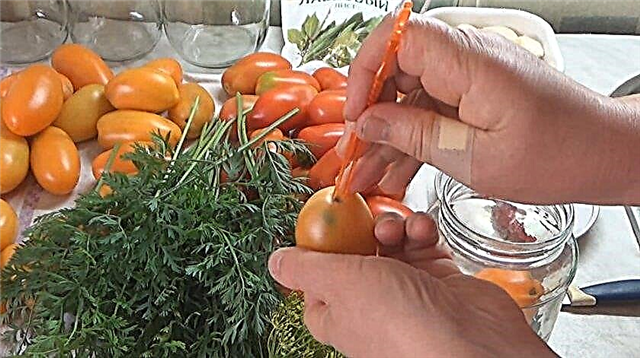
- Add bay leaf (it is better to place it closer to the walls of the jar) and cover the tomatoes with a few more branches of carrot tops.
- Pour boiling water over the contents of the cans, cover and steam for 20 minutes.

- After the specified time, drain the water into a measuring pan and place on the stove.
- Based on the amount of fluid available, immediately add salt and sugar to the container. Bring the mixture to a boil and leave it on the stove for another 2-3 minutes to completely dissolve the components.
- Remove the marinade from the stove, add citric acid and mix well.
- Pour the boiled marinade into the jar, close it with a lid (screw or for a seaming machine) and, turning it over, send it to cool under the table, after wrapping it in a warm blanket or an old jacket. Once the workpiece has completely cooled down, it can be transferred to the cellar or taken out to a cool pantry for further storage.
Video: Pickled tomatoes with carrot tops
With grape
The combination of tomatoes and grapes seems to many a strange solution, but in fact, these fruits really complement each other quite well.
To create a blank according to this recipe you need to prepare (for a can of 1.5 l):- bay leaf - 2 pcs.;
- black pepper - 5–7 peas;
- cloves - 5 pcs.;
- tarragon (can be replaced with dill inflorescences) - 5 g;
- garlic - 1 clove;
- onion - 1 ringlet;
- chili pepper - 2 rings;
- salt - 1 tbsp. l .;
- sugar - 3 tbsp. l .;
- vinegar - 2 tbsp. l

Cooking method:
- On the bottom of each prepared container, lay the bay leaves, cloves, tarragon, black pepper, chili pepper, onion and chopped garlic.
- Wash the tomato fruits and place them tightly in a jar, filling the container to about the middle.
- Put small bunches of grapes on top of the tomatoes (can be divided into small branches, 3-5 grapes each), but only so that another layer of tomatoes fits in the jar.
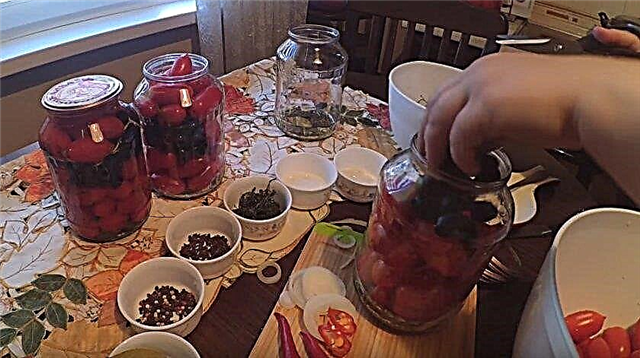
- Lay out the tomato fruits so that the grape “layer” is obtained between the lower and upper tiers.

- Pour boiling water over the contents of the jar and cover with a lid, leaving it for 15 minutes.
- After the allotted time, drain the liquid, boil it over low heat and repeat the procedure.
- After the second processing of tomatoes, pour the marinade into a measuring pot and send to the stove.
- Add salt, sugar, vinegar and bring the mixture to a boil.
- Pour the tomatoes again with a hot marinade and roll each jar of lid.
- Turn the container upside down, cover with a blanket and leave to cool at room temperature in order to later transfer it to a permanent storage location.
Any of the described recipes can be the crown choice, because in order to choose the most delicious and affordable solution for the blanks, you will have to try more than one recipe. Each of them has its own characteristic features and nuances of implementation, but if you adhere to the above instructions, no difficulties should arise.

















